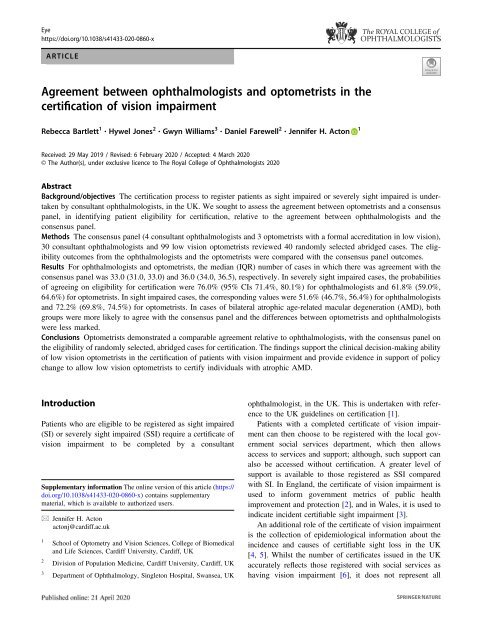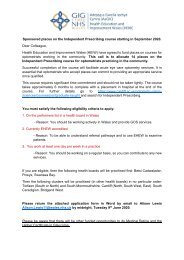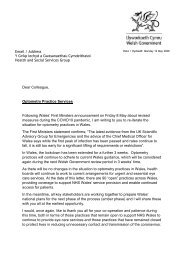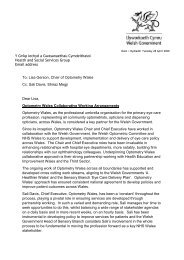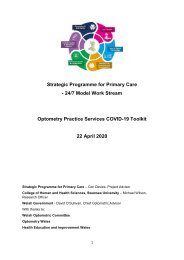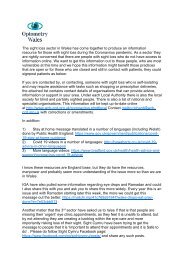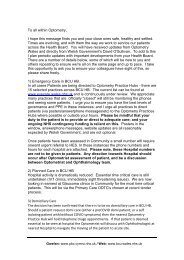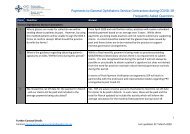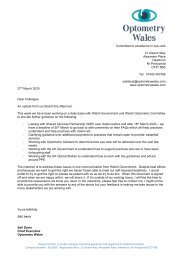Bartlett_et_al-2020-Eye
You also want an ePaper? Increase the reach of your titles
YUMPU automatically turns print PDFs into web optimized ePapers that Google loves.
<strong>Eye</strong><br />
https://doi.org/10.1038/s41433-020-0860-x<br />
ARTICLE<br />
Agreement b<strong>et</strong>ween ophth<strong>al</strong>mologists and optom<strong>et</strong>rists in the<br />
certification of vision impairment<br />
Rebecca <strong>Bartl<strong>et</strong>t</strong> 1 ●<br />
Hywel Jones 2 ●<br />
Gwyn Williams 3 ●<br />
Daniel Farewell 2 ●<br />
Jennifer H. Acton 1<br />
Received: 29 May 2019 / Revised: 6 February <strong>2020</strong> / Accepted: 4 March <strong>2020</strong><br />
© The Author(s), under exclusive licence to The Roy<strong>al</strong> College of Ophth<strong>al</strong>mologists <strong>2020</strong><br />
1234567890();,:<br />
1234567890();,:<br />
Abstract<br />
Background/objectives The certification process to register patients as sight impaired or severely sight impaired is undertaken<br />
by consultant ophth<strong>al</strong>mologists, in the UK. We sought to assess the agreement b<strong>et</strong>ween optom<strong>et</strong>rists and a consensus<br />
panel, in identifying patient eligibility for certification, relative to the agreement b<strong>et</strong>ween ophth<strong>al</strong>mologists and the<br />
consensus panel.<br />
M<strong>et</strong>hods The consensus panel (4 consultant ophth<strong>al</strong>mologists and 3 optom<strong>et</strong>rists with a form<strong>al</strong> accreditation in low vision),<br />
30 consultant ophth<strong>al</strong>mologists and 99 low vision optom<strong>et</strong>rists reviewed 40 randomly selected abridged cases. The eligibility<br />
outcomes from the ophth<strong>al</strong>mologists and the optom<strong>et</strong>rists were compared with the consensus panel outcomes.<br />
Results For ophth<strong>al</strong>mologists and optom<strong>et</strong>rists, the median (IQR) number of cases in which there was agreement with the<br />
consensus panel was 33.0 (31.0, 33.0) and 36.0 (34.0, 36.5), respectively. In severely sight impaired cases, the probabilities<br />
of agreeing on eligibility for certification were 76.0% (95% CIs 71.4%, 80.1%) for ophth<strong>al</strong>mologists and 61.8% (59.0%,<br />
64.6%) for optom<strong>et</strong>rists. In sight impaired cases, the corresponding v<strong>al</strong>ues were 51.6% (46.7%, 56.4%) for ophth<strong>al</strong>mologists<br />
and 72.2% (69.8%, 74.5%) for optom<strong>et</strong>rists. In cases of bilater<strong>al</strong> atrophic age-related macular degeneration (AMD), both<br />
groups were more likely to agree with the consensus panel and the differences b<strong>et</strong>ween optom<strong>et</strong>rists and ophth<strong>al</strong>mologists<br />
were less marked.<br />
Conclusions Optom<strong>et</strong>rists demonstrated a comparable agreement relative to ophth<strong>al</strong>mologists, with the consensus panel on<br />
the eligibility of randomly selected, abridged cases for certification. The findings support the clinic<strong>al</strong> decision-making ability<br />
of low vision optom<strong>et</strong>rists in the certification of patients with vision impairment and provide evidence in support of policy<br />
change to <strong>al</strong>low low vision optom<strong>et</strong>rists to certify individu<strong>al</strong>s with atrophic AMD.<br />
Introduction<br />
Patients who are eligible to be registered as sight impaired<br />
(SI) or severely sight impaired (SSI) require a certificate of<br />
vision impairment to be compl<strong>et</strong>ed by a consultant<br />
Supplementary information The online version of this article (https://<br />
doi.org/10.1038/s41433-020-0860-x) contains supplementary<br />
materi<strong>al</strong>, which is available to authorized users.<br />
* Jennifer H. Acton<br />
actonj@cardiff.ac.uk<br />
1<br />
2<br />
3<br />
School of Optom<strong>et</strong>ry and Vision Sciences, College of Biomedic<strong>al</strong><br />
and Life Sciences, Cardiff University, Cardiff, UK<br />
Division of Population Medicine, Cardiff University, Cardiff, UK<br />
Department of Ophth<strong>al</strong>mology, Singl<strong>et</strong>on Hospit<strong>al</strong>, Swansea, UK<br />
ophth<strong>al</strong>mologist, in the UK. This is undertaken with reference<br />
to the UK guidelines on certification [1].<br />
Patients with a compl<strong>et</strong>ed certificate of vision impairment<br />
can then choose to be registered with the loc<strong>al</strong> government<br />
soci<strong>al</strong> services department, which then <strong>al</strong>lows<br />
access to services and support; <strong>al</strong>though, such support can<br />
<strong>al</strong>so be accessed without certification. A greater level of<br />
support is available to those registered as SSI compared<br />
with SI. In England, the certificate of vision impairment is<br />
used to inform government m<strong>et</strong>rics of public he<strong>al</strong>th<br />
improvement and protection [2], and in W<strong>al</strong>es, it is used to<br />
indicate incident certifiable sight impairment [3].<br />
An addition<strong>al</strong> role of the certificate of vision impairment<br />
is the collection of epidemiologic<strong>al</strong> information about the<br />
incidence and causes of certifiable sight loss in the UK<br />
[4, 5]. Whilst the number of certificates issued in the UK<br />
accurately reflects those registered with soci<strong>al</strong> services as<br />
having vision impairment [6], it does not represent <strong>al</strong>l
R. <strong>Bartl<strong>et</strong>t</strong> <strong>et</strong> <strong>al</strong>.<br />
individu<strong>al</strong>s living with sight loss. Indeed, it is estimated that<br />
up to 51% of those eligible for certification are not certified<br />
[7–9] and the incidence of certification varies across geographic<strong>al</strong><br />
locations [10]. From studies involving medic<strong>al</strong><br />
record review [7, 8, 11] and patient interviews [9], it was<br />
found that those with a treatable condition or receiving<br />
ongoing treatment were less likely to be certified than those<br />
with untreatable conditions. In addition, those from <strong>et</strong>hnic<br />
minorities were less likely to be certified than Caucasian<br />
patients [7, 9] and those with visu<strong>al</strong> field loss <strong>al</strong>one were<br />
less likely to be certified than those with reduced visu<strong>al</strong><br />
acuity [8].<br />
There is a mismatch in demand and capacity for available<br />
secondary care ophth<strong>al</strong>mology appointments, and the long<br />
waiting times for appointments may put individu<strong>al</strong>s at risk of<br />
irreversible sight loss [4]. Given the care capacity issues, the<br />
role of the primary care optom<strong>et</strong>rist has expanded, with the<br />
introduction and development of enhanced eye care services<br />
[12].<br />
In W<strong>al</strong>es, over 8500 individu<strong>al</strong>s with low vision are<br />
examined by the primary care-based Low Vision Service<br />
W<strong>al</strong>es (LVSW) each year. Registration with vision<br />
impairment is not a prerequisite for access to this service.<br />
The LVSW is provided by 184 practitioners (171 optom<strong>et</strong>rists<br />
and 13 dispensing opticians) who have compl<strong>et</strong>ed and<br />
continuously undergo speci<strong>al</strong>ist training.<br />
In order to assess the appropriateness of an expanded role of<br />
LVSW accredited optom<strong>et</strong>rists in the certification of vision<br />
impairment, there is a need to ev<strong>al</strong>uate their clinic<strong>al</strong> ability in<br />
identifying the eligibility of a range of individu<strong>al</strong>s for certification.<br />
The aims of this study were twofold. First, to assess the<br />
agreement b<strong>et</strong>ween optom<strong>et</strong>rists and a consensus panel, in<br />
identifying patient eligibility for certification, relative to the<br />
agreement b<strong>et</strong>ween ophth<strong>al</strong>mologists and the consensus panel.<br />
The second aim was to explore wh<strong>et</strong>her the agreement b<strong>et</strong>ween<br />
clinician groups and the consensus panel was influenced by the<br />
presence of bilater<strong>al</strong> atrophic age-related macular degeneration<br />
(AMD) as the cause of vision impairment. This is important<br />
given the potenti<strong>al</strong> to influence policy in W<strong>al</strong>es in the certification<br />
of patients with bilater<strong>al</strong> atrophic AMD by optom<strong>et</strong>rists,<br />
as the clinic<strong>al</strong> management of this group is predominantly<br />
based in primary care.<br />
Materi<strong>al</strong>s and m<strong>et</strong>hods<br />
Case records from 40 individu<strong>al</strong>s were selected at random<br />
(www.random.org), from 8000 patients seen by the LVSW<br />
b<strong>et</strong>ween April 2017 and April 2018, stratified by the three<br />
categories of severity of sight loss and anonymised. The<br />
case records for each individu<strong>al</strong> conformed to the following<br />
inclusion criteria: consent had been given to use the data for<br />
research and individu<strong>al</strong>s were at least 18 years old.<br />
D<strong>et</strong>ails from each case record were transferred to a<br />
proforma and consisted of: age, gender, time since diagnosis,<br />
occupation, soci<strong>al</strong> and living situation, gener<strong>al</strong> he<strong>al</strong>th,<br />
the presence of a hearing impairment, problems reported,<br />
support received to date, diagnosis (right and left eye),<br />
refraction (distance and near), visu<strong>al</strong> acuity (distance and<br />
near, monocular and binocular), binocular contrast sensitivity<br />
(measured using the Pelli–Robson chart, reported in<br />
terms of percentage loss and wh<strong>et</strong>her the loss was considered<br />
as: norm<strong>al</strong>, noticeable loss, significant loss, severe<br />
loss [13]) and the visu<strong>al</strong> field status. Visu<strong>al</strong> field printouts<br />
were included where available.<br />
The consensus panel consisted of four consultant ophth<strong>al</strong>mologists<br />
and three LVSW optom<strong>et</strong>rists. Each consultant<br />
had been registered with the Gener<strong>al</strong> Medic<strong>al</strong><br />
Council speci<strong>al</strong>ist register for ophth<strong>al</strong>mology for at least 2<br />
years and had undergone the standard 7 years of speci<strong>al</strong>ity<br />
training prior to this. Each of the LVSW optom<strong>et</strong>rists had<br />
been registered with the Gener<strong>al</strong> Optic<strong>al</strong> Council in addition<br />
to speci<strong>al</strong>ising in low vision for at least 15 years and had<br />
each compl<strong>et</strong>ed a Masters-level qu<strong>al</strong>ification in low vision.<br />
The consensus panel m<strong>et</strong> to d<strong>et</strong>ermine the certification<br />
eligibility of each of the anonymised case records based on<br />
the information presented. In cases of disagreement on the<br />
certification outcome, the case was discussed until unanimous<br />
agreement was reached.<br />
An anonymous online survey was then created<br />
(https://www.onlinesurveys.ac.uk), in order to present each<br />
of the case records in a random order for each new<br />
respondent. All Nation<strong>al</strong> He<strong>al</strong>th Service consultant ophth<strong>al</strong>mologists<br />
practicing in W<strong>al</strong>es (n = 58) and <strong>al</strong>l LVSW<br />
optom<strong>et</strong>rists (n = 162) were invited to take part as raters in<br />
the online survey to ev<strong>al</strong>uate the 40 case records. Consultant<br />
ophth<strong>al</strong>mologists and LVSW optom<strong>et</strong>rists who were<br />
in either the consensus panel and/or the research team were<br />
excluded from the survey. The survey was compl<strong>et</strong>ed<br />
without time or other restrictions in an unsupervised<br />
environment.<br />
Raters were asked to decide on the certification eligibility<br />
status (not eligible, SI, or SSI) of each of the 40 cases, with<br />
reference to the English guidelines (Department of He<strong>al</strong>th<br />
2013). These guidelines were provided at the start of the<br />
online survey, and were available to be viewed within each<br />
of the 40 cases.<br />
The survey was available for compl<strong>et</strong>ion from the 23rd<br />
April 2018 until 3rd July 2018. An incentive of 18 GBP was<br />
offered to optom<strong>et</strong>rists to compl<strong>et</strong>e the survey. A pragmatic<br />
decision was taken not to offer the incentive to the ophth<strong>al</strong>mologists.<br />
It was advised by the ophth<strong>al</strong>mologists on<br />
the consensus panel that payment to the ophth<strong>al</strong>mologist<br />
participants would not have a significant effect on participation<br />
and the administrative process of claiming a payment<br />
could act as a disincentive to participation.
Agreement b<strong>et</strong>ween ophth<strong>al</strong>mologists and optom<strong>et</strong>rists in the certification of vision impairment<br />
Fig. 1 Case characteristics and agreement with consensus panel.<br />
a The percentage of cases by gender and consensus panel outcome,<br />
according to demographic and clinic<strong>al</strong> characteristics. b The consensus<br />
panel outcome with respect to visu<strong>al</strong> acuity and time since diagnosis.<br />
c The number of cases out of 40 in which ophth<strong>al</strong>mologists (left) and<br />
optom<strong>et</strong>rists (right) agreed with the consensus panel in the assessment<br />
of eligibility for certification as a dichotomous variable (not eligible<br />
or eligible; top) and as a trichotomous variable (bottom). d The<br />
Ethic<strong>al</strong> approv<strong>al</strong> was gained from the School of Optom<strong>et</strong>ry<br />
and Vision Sciences research <strong>et</strong>hics and audit committee<br />
(approv<strong>al</strong> number 1443) at Cardiff University.<br />
Consent to take part in the study was obtained at the<br />
beginning of the online survey. The research was conducted<br />
according to the ten<strong>et</strong>s of the Declaration of Helsinki.<br />
An<strong>al</strong>ysis<br />
The agreement b<strong>et</strong>ween each rater group and the consensus<br />
panel was d<strong>et</strong>ermined using eligibility as both a trichotomous<br />
variable (not eligible, SI, SSI) and a dichotomous variable (not<br />
eligible or eligible, i.e. encompassing both SI and SSI).<br />
Modelling was then undertaken using the outcome: exact<br />
agreement with panel/disagree with panel. Given the 129 ratings<br />
for each case, i.e., one rating from each ophth<strong>al</strong>mologist<br />
and optom<strong>et</strong>rist, we used a multilevel model in which interrater<br />
variability was quantified using a random effect. Initi<strong>al</strong>ly,<br />
distributions of the number of cases out of 40 in which ophth<strong>al</strong>mologists<br />
and optom<strong>et</strong>rists agreed with the consensus panel in the<br />
assessment of eligibility for certification as a dichotomous variable<br />
(not eligible or eligible; left panel) and a trichotomous variable (not<br />
eligible, sight impaired, or severely sight impaired; right panel).<br />
Boxplot limits in (b) and (d) indicate the lower sample quartile, sample<br />
median and upper sample quartile.<br />
the variable, agreement (exact agreement with panel/disagree<br />
with panel), was modelled as an outcome in a logistic regression<br />
on rater group (ophth<strong>al</strong>mologist/optom<strong>et</strong>rist), consensus<br />
panel eligibility rating, and an interaction term b<strong>et</strong>ween the<br />
two. In addition, bilater<strong>al</strong> atrophic AMD was then included as<br />
another variable in the modelling.<br />
Krippendorff’s <strong>al</strong>pha was used to c<strong>al</strong>culate inter-rater<br />
agreement within each clinician group and is appropriate for<br />
use with the trichotomous rating outcomes [14].<br />
All an<strong>al</strong>yses were conducted in R Version 3.5.1 and mixed<br />
effects models were fitted using the lme4 package [15].<br />
Results<br />
The demographic and clinic<strong>al</strong> d<strong>et</strong>ails of each of the 40 cases<br />
are shown in Table S1 (online only supplementary table)<br />
and in Fig. 1a, b. Primary causes of vision loss in the 40
R. <strong>Bartl<strong>et</strong>t</strong> <strong>et</strong> <strong>al</strong>.<br />
Table 1 Case characteristics by<br />
consensus panel outcome.<br />
Consensus panel outcome<br />
Not eligible<br />
Eligible<br />
Sight impaired (SI)<br />
Severely sight<br />
impaired (SSI)<br />
Number of cases<br />
Tot<strong>al</strong> 12 15 13<br />
Case characteristic<br />
Sex<br />
M<strong>al</strong>e 5 5 7<br />
Fem<strong>al</strong>e 7 10 6<br />
Age-related macular degeneration 4 12 7<br />
Bilater<strong>al</strong> atrophic age-related 3 4 5<br />
macular degeneration<br />
Lives <strong>al</strong>one 1 10 7<br />
Hearing impaired 1 4 2<br />
Median (IQR)<br />
Age 78.5 (73.8, 86.0) 79.0 (71.5, 81.0) 79.0 (73.0, 81.0)<br />
Binocular distance visu<strong>al</strong> acuity 0.44 (0.30, 0.70) 0.90 (0.84, 1.00) 1.30 (1.00, 1.30)<br />
(LogMAR)<br />
Years since diagnosis 6 (4, 10) 4 (2, 5.75) a 4.5 (2, 6.25) b<br />
a Based on 14 cases.<br />
Based on 12 due to missing data.<br />
Table 2 Number of ratings by<br />
trichotomous classification of<br />
cases by the consensus panel<br />
and by each rater group.<br />
Consensus panel outcome<br />
Not eligible<br />
Eligible<br />
Rater group Rater group’s classification Sight impaired (SI) Severely sight<br />
impaired (SSI)<br />
Ophth<strong>al</strong>mologists<br />
Not eligible 339 183 26<br />
Sight impaired (SI) 19 232 68<br />
Severely sight<br />
2 35 296<br />
impaired (SSI)<br />
Optom<strong>et</strong>rists<br />
Not eligible 1042 328 4<br />
Sight impaired (SI) 138 1071 488<br />
Severely sight<br />
impaired (SSI)<br />
8 86 795<br />
It<strong>al</strong>icised v<strong>al</strong>ues indicate disagreement on over<strong>al</strong>l eligibilty status.<br />
case records included: cataract, neovascular and atrophic<br />
AMD, Stargardt disease, cone dystrophy, diab<strong>et</strong>ic eye disease,<br />
glaucoma, optic neuritis, nystagmus, r<strong>et</strong>in<strong>al</strong> d<strong>et</strong>achment,<br />
homonymous hemianopia resulting from stroke and<br />
r<strong>et</strong>initis pigmentosa.<br />
Of the 40 cases, the consensus panel agreed that 12 were<br />
not eligible for certification, 15 were eligible to be certified<br />
as SI, and 13 certified as SSI (Table 1). There were no cases<br />
in which a group agreement by the consensus panel was not<br />
reached.<br />
Survey responses from 30 consultant ophth<strong>al</strong>mologists<br />
and 99 low vision optom<strong>et</strong>rists were received, accounting<br />
for 52% and 61% of those eligible to take part (i.e. the tot<strong>al</strong><br />
number of clinicians in W<strong>al</strong>es) from each rater group,<br />
respectively.<br />
Each of the 40 cases therefore was rated by 129 clinicians,<br />
giving a tot<strong>al</strong> of 5160 ratings. Ophth<strong>al</strong>mologists<br />
produced 1200 ratings; and optom<strong>et</strong>rists, 3960 (Table 2).<br />
These were not independent observations: each of the 129<br />
raters classified the same 40 cases. The 28 cases rated as
Agreement b<strong>et</strong>ween ophth<strong>al</strong>mologists and optom<strong>et</strong>rists in the certification of vision impairment<br />
Table 3 Modelling outcomes<br />
showing the estimated<br />
probability of rating the<br />
eligibility of the cases in exact<br />
agreement with the consensus<br />
panel, for each rater group, with<br />
95% confidence interv<strong>al</strong>s<br />
derived from the fitted model.<br />
Rater group<br />
Consensus panel<br />
outcome<br />
Probability of rater group<br />
agreeing exactly with<br />
consensus panel<br />
95% confidence<br />
interv<strong>al</strong><br />
Lower limit<br />
Upper limit<br />
Ophth<strong>al</strong>mologists Not eligible 0.942 0.913 0.962<br />
Optom<strong>et</strong>rists Not eligible 0.878 0.858 0.896<br />
Ophth<strong>al</strong>mologists SI 0.516 0.467 0.564<br />
Optom<strong>et</strong>rists SI 0.722 0.698 0.745<br />
Ophth<strong>al</strong>mologists SSI 0.760 0.714 0.801<br />
Optom<strong>et</strong>rists SSI 0.618 0.590 0.646<br />
eligible for certification by the panel thus provided 28 ×<br />
30 = 840 observations by ophth<strong>al</strong>mologists and 28 × 99 =<br />
2772 observations by optom<strong>et</strong>rists. Seventy-five percent<br />
(n = 631) of the ophth<strong>al</strong>mologists’ ratings of those cases<br />
were eligible for certification. Eighty-eight percent (n =<br />
2440) were eligible in the optom<strong>et</strong>rists’ view (Table 2).<br />
Compared with the consensus panel who considered 12<br />
of the cases to be ineligible, a median of 19 (IQR 18.25, 20)<br />
cases were rated ineligible by ophth<strong>al</strong>mologists and 14 (12,<br />
16) by optom<strong>et</strong>rists. Fifteen cases were rated as SI by the<br />
consensus panel, whilst 11 (9.25, 11) and 17 (15, 19) cases<br />
were rated as SI by the ophth<strong>al</strong>mologists and optom<strong>et</strong>rists,<br />
respectively. Thirteen cases were rated as SSI by the consensus<br />
panel, whilst 10 (9.25, 10) and 8 (7, 11) cases were<br />
rated as SSI by ophth<strong>al</strong>mologists and optom<strong>et</strong>rists, respectively.<br />
This, however, does not indicate the level of agreement<br />
concerning individu<strong>al</strong> cases. We then d<strong>et</strong>ermined, for<br />
each case and rater, wh<strong>et</strong>her the rater agreed with the<br />
consensus panel’s outcome, either when considering the<br />
dichotomous (eligible/not eligible) rating or the trichotomous<br />
(not eligible/SI/SSI) rating.<br />
The agreement b<strong>et</strong>ween each rater group with the consensus<br />
panel is shown in Fig. 1c. Figure 1d is an <strong>al</strong>ternative<br />
presentation of the same data. For the dichotomous rating,<br />
the optom<strong>et</strong>rists’ distribution is clearly different to the<br />
ophth<strong>al</strong>mologists’ and in b<strong>et</strong>ter accord with the consensus<br />
panel’s outcome. For ophth<strong>al</strong>mologists, the median (IQR)<br />
number of cases in which there was agreement with the<br />
consensus panel was 33.0 (31.0, 33.0); corresponding<br />
v<strong>al</strong>ues for optom<strong>et</strong>rists were 36.0 (34.0, 36.5). For ophth<strong>al</strong>mologists,<br />
the mode was 33, in which 13 ophth<strong>al</strong>mologists<br />
(43%) agreed with the consensus panel. Similarly, for<br />
optom<strong>et</strong>rists, the mode was 36 cases, in which 26 optom<strong>et</strong>rists<br />
(26%) agreed with the consensus panel. For the<br />
trichotomous rating, the median (IQR) number of cases in<br />
which there was full agreement with the consensus panel<br />
was 30.0 (28.3, 30.0); corresponding v<strong>al</strong>ues for optom<strong>et</strong>rists<br />
were 30.0 (27.0, 31.5).<br />
Table 3 (charted in Fig. 2a) shows the probability of<br />
rating the eligibility of the cases in exact agreement with the<br />
consensus panel, for each rater group, tog<strong>et</strong>her with 95%<br />
confidence interv<strong>al</strong>s derived from the fitted model. The<br />
greatest differences b<strong>et</strong>ween optom<strong>et</strong>rists and ophth<strong>al</strong>mologists<br />
occurred for cases d<strong>et</strong>ermined by the consensus panel<br />
as SI: optom<strong>et</strong>rists considered 72% of those cases as SI<br />
while ophth<strong>al</strong>mologists rated only 52% as SI (95% CIs<br />
0.70, 0.75 cf. 0.47, 0.56). For cases rated as SSI by the<br />
consensus panel, optom<strong>et</strong>rists and ophth<strong>al</strong>mologists considered<br />
62% and 76% as SSI, respectively (95% CIs 0.59,<br />
0.65 cf. 0.71, 0.80). Agreement on cases that were,<br />
according to the consensus panel, not eligible, was closer<br />
b<strong>et</strong>ween clinician groups.<br />
Bilater<strong>al</strong> atrophic AMD was then added in to the model<br />
as an explanatory variable (Fig. 2a, bottom panel), which<br />
was selected for inclusion given its clinic<strong>al</strong> significance.<br />
Over<strong>al</strong>l, both clinician groups were more likely to agree<br />
with the consensus panel outcomes for cases of bilater<strong>al</strong><br />
atrophic AMD than for cases in which it was not present. As<br />
previously, the greatest differences b<strong>et</strong>ween optom<strong>et</strong>rists<br />
and ophth<strong>al</strong>mologists occurred for cases eligible for certification<br />
as SI; however, these differences were less marked<br />
in cases of bilater<strong>al</strong> atrophic AMD.<br />
As Fig. 2b (top panel) suggests, both ophth<strong>al</strong>mologists<br />
and optom<strong>et</strong>rists largely agreed that those cases considered<br />
not eligible by the consensus panel were truly ineligible and<br />
that the cases considered SSI by the panel were eligible.<br />
Figure 2b (top panel) shows that for both groups, the<br />
classification of most cases was unambiguous: 19 of the<br />
cases were judged as eligible by over 90% of the optom<strong>et</strong>rists,<br />
while a further 6 of the cases were considered eligible<br />
by less than 10% of the optom<strong>et</strong>rists, i.e., over 90% of the<br />
optom<strong>et</strong>rists considered those 6 to be ineligible. Ophth<strong>al</strong>mologists<br />
demonstrated a similar pattern with near unanimity<br />
over the classification of 16 cases as eligible and 12<br />
cases were considered eligible by less than 10% of the<br />
ophth<strong>al</strong>mologists. For the cases d<strong>et</strong>ermined as SI by the<br />
consensus panel (Fig. 2b, bottom panel), there were seven<br />
cases in which less than 50% of ophth<strong>al</strong>mologists agreed<br />
with the consensus panel, but only two cases in which same<br />
was true for optom<strong>et</strong>rists.
R. <strong>Bartl<strong>et</strong>t</strong> <strong>et</strong> <strong>al</strong>.<br />
Fig. 2 The probability of agreement with consensus panel and<br />
distribution of cases judged as eligible. a The probability of agreeing<br />
with the consensus panel outcome, for each rater group. The vertic<strong>al</strong><br />
grey bars represent the 95% confidence interv<strong>al</strong>s. The top panel in<br />
(a) shows the over<strong>al</strong>l agreement and the bottom panel shows the<br />
agreement for cases in which the primary cause of vision impairment<br />
was (right) and was not (left) bilater<strong>al</strong> atrophic AMD. b Distribution of<br />
cases by percentage of raters judging the cases to be eligible. The top<br />
panel shows the over<strong>al</strong>l distribution. The bottom panel shows the<br />
distribution for cases d<strong>et</strong>ermined by the consensus panel as sight<br />
impaired only.<br />
There were 11 cases of compl<strong>et</strong>e agreement amongst <strong>al</strong>l<br />
the ophth<strong>al</strong>mologists and optom<strong>et</strong>rists, 1 of which <strong>al</strong>l considered<br />
ineligible, the others being eligible.<br />
Moderate to substanti<strong>al</strong> inter-rater agreement was<br />
demonstrated within each rater group. Based on <strong>al</strong>l 40<br />
cases, for ophth<strong>al</strong>mologists, Krippendorff’s <strong>al</strong>pha v<strong>al</strong>ues<br />
were 0.72 (95% CI 0.62–0.81) and 0.8 (0.70–0.88), for the<br />
dichotomous and trichotomous classifications, respectively.<br />
Similarly, the corresponding v<strong>al</strong>ues for optom<strong>et</strong>rists were<br />
0.67 (0.53–0.78) and 0.73 (0.63–0.81).<br />
Discussion<br />
This study ev<strong>al</strong>uated the clinic<strong>al</strong> decision-making abilities<br />
of low vision optom<strong>et</strong>rists and consultant ophth<strong>al</strong>mologists<br />
in certifying patients as vision impaired. Unlike the ophth<strong>al</strong>mologists,<br />
the optom<strong>et</strong>rists were inexperienced in the<br />
process of certification. However, low vision optom<strong>et</strong>rists<br />
are experienced in managing patients with low vision and<br />
thus have a theor<strong>et</strong>ic<strong>al</strong> understanding of the certification of<br />
vision impairment, but not a current role in the form<strong>al</strong><br />
certification process.<br />
The key finding of this study was that optom<strong>et</strong>rists<br />
demonstrated comparable agreement relative to ophth<strong>al</strong>mologists,<br />
with the consensus panel outcomes on the eligibility<br />
of cases for certification. The similarity in<br />
performance b<strong>et</strong>ween groups is demonstrated by the number<br />
of cases in which there was agreement with the consensus<br />
panel and the over<strong>al</strong>l probability of rating the<br />
eligibility of cases in exact agreement with the consensus<br />
panel. For cases rated as SI, the probability of agreement<br />
with the consensus panel was greater for optom<strong>et</strong>rists than<br />
for ophth<strong>al</strong>mologists, whilst the opposite was true for cases<br />
rated as SSI. Both clinician groups rated fewer cases as<br />
eligible relative to the consensus panel. Ophth<strong>al</strong>mologists<br />
were least likely to agree with the consensus panel outcome<br />
for cases judged by the consensus panel as SI, whilst<br />
optom<strong>et</strong>rists were least likely to agree with the consensus<br />
panel for SSI cases. Whilst the results for SSI cases may<br />
reflect the naiv<strong>et</strong>y of the optom<strong>et</strong>rists in the certification<br />
process, and may be partly explained by a stronger
Agreement b<strong>et</strong>ween ophth<strong>al</strong>mologists and optom<strong>et</strong>rists in the certification of vision impairment<br />
adherence to the clinic<strong>al</strong> guidelines, the over<strong>al</strong>l similarity<br />
b<strong>et</strong>ween groups supports their ability to provide this service<br />
to patients.<br />
In one case (case 3), classified as SI by the consensus<br />
panel, interestingly, 90% of the ophth<strong>al</strong>mologists classified<br />
this case as not eligible (Fig. 2b). Although this<br />
individu<strong>al</strong> had b<strong>et</strong>ter visu<strong>al</strong> acuities than the guideline<br />
criteria for certification, she had a severe loss of contrast<br />
sensitivity, recent diagnosis of AMD, and lived <strong>al</strong>one.<br />
This suggests the rating of the consensus panel may have<br />
<strong>al</strong>located more weighting to the circumstanti<strong>al</strong> factors<br />
than the visu<strong>al</strong> acuity status, relative to that of the ophth<strong>al</strong>mologists.<br />
Whilst contrast sensitivity is not specific<strong>al</strong>lymentionedinthecertification<br />
guidelines, clinicians<br />
may differ in their consideration of this outcome when it<br />
is available. However, decisions are never made on this<br />
outcome <strong>al</strong>one.<br />
Both clinician groups were more likely to agree with the<br />
consensus panel across <strong>al</strong>l eligibility classifications in cases<br />
of bilater<strong>al</strong> atrophic AMD, relative to the other causes of<br />
vision impairment. In these cases, the differences b<strong>et</strong>ween<br />
clinician groups were less, relative to those cases in which<br />
there was another cause of vision impairment, i.e., not<br />
atrophic AMD. This difference was most marked for the SI<br />
cases (Fig. 2a).<br />
AMD is the leading cause of certifiable vision impairment<br />
in England and W<strong>al</strong>es accounting for 50% of <strong>al</strong>l<br />
certifications of vision impairment [16] and of these cases,<br />
atrophic AMD is the leading cause of vision loss in ~50%<br />
[17]. Given the lack of clinic<strong>al</strong> therapeutic options for<br />
atrophic AMD, patients with this condition would not be<br />
routinely monitored within the hospit<strong>al</strong> eye service. Y<strong>et</strong>, the<br />
vision loss associated with severe atrophic AMD me<strong>et</strong>s the<br />
threshold for eligibility for certification. Therefore, these<br />
patients would particularly benefit from access to certification<br />
through primary care optom<strong>et</strong>ry, should it become<br />
available.<br />
This is the first study to measure the agreement b<strong>et</strong>ween<br />
optom<strong>et</strong>rists and consultant ophth<strong>al</strong>mologists in the consideration<br />
of eligibility for certification of patients with<br />
vision impairment. Previous studies have examined the<br />
agreement b<strong>et</strong>ween optom<strong>et</strong>rists and ophth<strong>al</strong>mologists, in<br />
other clinic<strong>al</strong> tasks [18–23]. Some have shown moderate to<br />
substanti<strong>al</strong> agreement b<strong>et</strong>ween these groups in the grading<br />
of anterior chamber angles [19] and in the ev<strong>al</strong>uation of<br />
glaucoma [20–23]. Others have demonstrated poor levels of<br />
agreement b<strong>et</strong>ween and within consultant ophth<strong>al</strong>mologists,<br />
in classifying patients with glaucomatous visu<strong>al</strong> field<br />
defects [18]. However, such comparisons to the present<br />
study are limited given the different nature of these<br />
clinic<strong>al</strong> tasks.<br />
The strengths of the study include the substanti<strong>al</strong> proportion<br />
of clinicians relative to the over<strong>al</strong>l workforce in<br />
W<strong>al</strong>es who took part in the study. A consensus panel was<br />
adopted to provide a reference standard for clinic<strong>al</strong><br />
decision-making.<br />
The limitations of the study include the online delivery of<br />
the survey, which may have resulted in the self-selection of<br />
clinicians with a specific interest to act as participants. A<br />
moderate number of anonymised cases were reviewed,<br />
<strong>al</strong>though they were representative of the vari<strong>et</strong>y of disease<br />
types and individu<strong>al</strong> circumstances of such cases. The<br />
grading of anonymised cases does not fully simulate the<br />
interaction that occurs b<strong>et</strong>ween a clinician and a patient. In<br />
addition, whilst the ophth<strong>al</strong>mologists were experienced in<br />
the re<strong>al</strong> life process of certification, neither of the clinician<br />
groups were familiar with the task of classifying abridged<br />
cases. A possible risk of bias could be attributed to the<br />
incentivisation to optom<strong>et</strong>rists but not ophth<strong>al</strong>mologists,<br />
however, the payment was offered independently of performance<br />
in the classification task, and therefore should be<br />
expected to be independent of the recorded outcomes for<br />
each participant. All optom<strong>et</strong>rist participants claimed the<br />
incentive.<br />
Although the possibility that an ophth<strong>al</strong>mologist participant<br />
compl<strong>et</strong>ed the survey more than once cannot be<br />
excluded, it is unlikely, given the time taken to review<br />
each case, which was presented in a random order in each<br />
survey.<br />
Over<strong>al</strong>l, the performance of optom<strong>et</strong>rists was comparable<br />
to that of ophth<strong>al</strong>mologists in the rating of eligibility<br />
of virtu<strong>al</strong> patient cases for the certification of vision<br />
impairment. The findings support the clinic<strong>al</strong> decisionmaking<br />
ability of low vision optom<strong>et</strong>rists in the certification<br />
of patients with vision impairment, especi<strong>al</strong>ly in<br />
cases of atrophic AMD. A prospective study comparing<br />
the assessment of patients with bilater<strong>al</strong> atrophic AMD<br />
by low vision optom<strong>et</strong>rists against a reference standard is<br />
warranted.<br />
Main findings<br />
●<br />
●<br />
●<br />
●<br />
The findings support the clinic<strong>al</strong> decision-making ability<br />
of low vision optom<strong>et</strong>rists in the certification of patients<br />
with vision impairment.<br />
Optom<strong>et</strong>rists demonstrated a comparable agreement<br />
relative to ophth<strong>al</strong>mologists, with a consensus panel<br />
on the eligibility of randomly selected, abridged cases<br />
for certification.<br />
Both clinician groups were more likely to agree with the<br />
consensus panel in cases of bilater<strong>al</strong> atrophic AMD,<br />
relative to the other causes of vision impairment.<br />
The results provide evidence in support of policy change<br />
to <strong>al</strong>low low vision optom<strong>et</strong>rists to certify individu<strong>al</strong>s<br />
with atrophic AMD.
R. <strong>Bartl<strong>et</strong>t</strong> <strong>et</strong> <strong>al</strong>.<br />
Summary<br />
What was known before<br />
●<br />
The certification process to register patients as sight<br />
impaired or severely sight impaired is undertaken by<br />
consultant ophth<strong>al</strong>mologists, in the UK.<br />
What this study adds<br />
●<br />
Ophth<strong>al</strong>mologists and optom<strong>et</strong>rists demonstrated an<br />
equiv<strong>al</strong>ent rating of cases for the certification of vision<br />
impairment. The evidence suggests that it is feasible for<br />
low vision optom<strong>et</strong>rists to certify patients with atrophic<br />
age-related macular degeneration.<br />
Acknowledgements The study was funded by the charitable organisation,<br />
Sight Cymru. We are <strong>al</strong>so grateful to the consensus panel<br />
members and to <strong>al</strong>l study participants.<br />
Compliance with <strong>et</strong>hic<strong>al</strong> standards<br />
Conflict of interest The authors declare that they have no conflict of<br />
interest.<br />
Publisher’s note Springer Nature remains neutr<strong>al</strong> with regard to<br />
jurisdiction<strong>al</strong> claims in published maps and institution<strong>al</strong> affiliations.<br />
References<br />
1. CVI—Certificate of Vision Impairment. Roy<strong>al</strong> College of Ophth<strong>al</strong>mologists.<br />
2019. https://www.rcophth.ac.uk/profession<strong>al</strong>resources/certificate-of-vision-impairment/.<br />
2. Certificate of Vision Impairment. Department of He<strong>al</strong>th. 2019.<br />
https://ass<strong>et</strong>s.publishing.service.gov.uk/government/uploads/<br />
system/uploads/attachment_data/file/637590/CVI_guidance.pdf.<br />
3. Sensory He<strong>al</strong>th: <strong>Eye</strong> Care and Hearing Statistics, 2017–18 &<br />
2018–19. Welsh Government. 2019. https://gov.w<strong>al</strong>es/sites/defa<br />
ult/files/statistics-and-research/2019-06/sensory-he<strong>al</strong>th-eye-care-a<br />
nd-hearing-statistics-april-2017-march-2018-revised.pdf.<br />
4. Boyce T. Re<strong>al</strong> patients coming to re<strong>al</strong> harm: ophth<strong>al</strong>mology services<br />
in W<strong>al</strong>es. Roy<strong>al</strong> Nation<strong>al</strong> Institute of Blind People. 2019.<br />
https://www.rnib.org.uk/sites/default/files/Re<strong>al</strong>_patients_coming_<br />
to_re<strong>al</strong>_harm_.pdf.<br />
5. Mitry D, Bunce C, Worm<strong>al</strong>d R, Leamon S, Simkiss P, Cumberland<br />
P, <strong>et</strong> <strong>al</strong>. Causes of certifications for severe sight impairment<br />
(blind) and sight impairment (parti<strong>al</strong> sight) in children in England<br />
and W<strong>al</strong>es. Br J Ophth<strong>al</strong>mol. 2013;97:1431–6.<br />
6. Rees A, Bunce C, Patel P. Caution needed when examining certificate<br />
of vision impairment rates: the new public he<strong>al</strong>th indicator.<br />
<strong>Eye</strong>. 2013;27:892–892.<br />
7. Barry RJ, Murray PI. Unregistered visu<strong>al</strong> impairment: is registration<br />
a failing system? Br J Ophth<strong>al</strong>mol. 2005;89:995–8.<br />
8. Bunce C, Evans J, Fraser S, Worm<strong>al</strong>d R. BD8 certification of<br />
visu<strong>al</strong>ly impaired people. Br J Ophth<strong>al</strong>mol. 1998;82:72–76.<br />
9. Robinson R, Deutsch J, Jones HS, Youngson-Reilly S, Hamlin<br />
DM, Dhurjon L, <strong>et</strong> <strong>al</strong>. Unrecognised and unregistered visu<strong>al</strong><br />
impairment. Br J Ophth<strong>al</strong>mol. 1994;78:736–40.<br />
10. M<strong>al</strong>ik ANJ, Bunce C, Worm<strong>al</strong>d R, Suleman M, Stratton I, Gray<br />
JAM. Geographic<strong>al</strong> variation in certification rates of blindness and<br />
sight impairment in England, 2008-9. BMJ Open. 2012;2:e001496.<br />
11. King AJ, Reddy A, Thompson JR, Rosenth<strong>al</strong> AR. The rates of<br />
blindness and of parti<strong>al</strong> sight registration in glaucoma patients.<br />
<strong>Eye</strong>. 2000;14:613–9.<br />
12. Baker H, Ratnarajan G, Harper RA, Edgar DF, Lawrenson JG.<br />
Effectiveness of UK optom<strong>et</strong>ric enhanced eye care services: a<br />
re<strong>al</strong>ist review of the literature. Ophth<strong>al</strong>mic Physiol Opt.<br />
2016;36:545–57.<br />
13. Rumney NJ. Using visu<strong>al</strong> thresholds to establish low-vision performance.<br />
Ophth<strong>al</strong>mic Physiol Opt. 1995;15:S18–24.<br />
14. Zapf A, Castell S, Morawi<strong>et</strong>z L, Karch A. Measuring inter-rater<br />
reliability for nomin<strong>al</strong> data—which coefficients and confidence<br />
interv<strong>al</strong>s are appropriate? BMC Med Res M<strong>et</strong>hodol. 2016;16:93.<br />
15. Bates D, Mächler M, Bolker B, W<strong>al</strong>ker S. Fitting linear mixedeffects<br />
models using lme4. J Stat Softw. 2015;67:48.<br />
16. Quartilho A, Simkiss P, Zekite A, Xing W, Worm<strong>al</strong>d R, Bunce C.<br />
Leading causes of certifiable visu<strong>al</strong> loss in England and W<strong>al</strong>es<br />
during the year ending 31 March 2013. <strong>Eye</strong>. 2016;30:602–7.<br />
17. Rees A, Zekite A, Bunce C, Patel PJ. How many people in England<br />
and W<strong>al</strong>es are registered parti<strong>al</strong>ly sighted or blind because of<br />
age-related macular degeneration? <strong>Eye</strong>. 2014;28:832–7.<br />
18. Guerin E, Bouliotis G, King A. Visu<strong>al</strong> impairment registration:<br />
ev<strong>al</strong>uation of agreement among ophth<strong>al</strong>mologists. <strong>Eye</strong>.<br />
2014;28:808–13.<br />
19. Jind<strong>al</strong> A, Myint J, Edgar DF, Nolan WP, Lawrenson JG. Agreement<br />
among optom<strong>et</strong>rists and ophth<strong>al</strong>mologists in estimating<br />
limb<strong>al</strong> anterior chamber depth using the van Herick m<strong>et</strong>hod.<br />
Ophth<strong>al</strong>mic Physiol Opt. 2015;35:179–85.<br />
20. Azuara-Blanco A, Burr J, Thomas R, Maclennan G, McPherson S.<br />
The accuracy of accredited glaucoma optom<strong>et</strong>rists in the diagnosis<br />
and treatment recommendation for glaucoma. Br J Ophth<strong>al</strong>mol.<br />
2007;91:1639–43.<br />
21. Banes MJ, Culham LE, Bunce C, Xing W, Viswanathan A,<br />
Garway-Heath D. Agreement b<strong>et</strong>ween optom<strong>et</strong>rists and ophth<strong>al</strong>mologists<br />
on clinic<strong>al</strong> management decisions for patients with<br />
glaucoma. Br J Ophth<strong>al</strong>mol. 2006;90:579–85.<br />
22. Ho S, Vernon SA. Decision making in chronic glaucomaoptom<strong>et</strong>rists<br />
vs ophth<strong>al</strong>mologists in a shared care service. Ophth<strong>al</strong>mic<br />
Physiol Opt. 2011;31:168–73.<br />
23. Marks JR, Harding AK, Harper RA, Williams E, Haque S,<br />
Spencer AF, <strong>et</strong> <strong>al</strong>. Agreement b<strong>et</strong>ween speci<strong>al</strong>ly trained and<br />
accredited optom<strong>et</strong>rists and glaucoma speci<strong>al</strong>ist consultant ophth<strong>al</strong>mologists<br />
in their management of glaucoma patients. <strong>Eye</strong>.<br />
2012;26:853–61.


